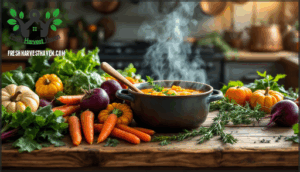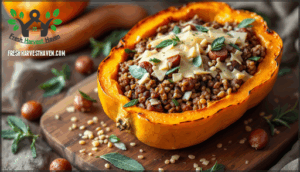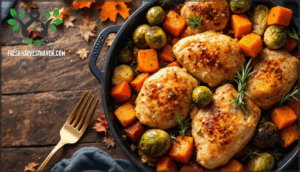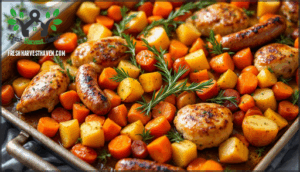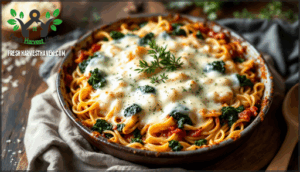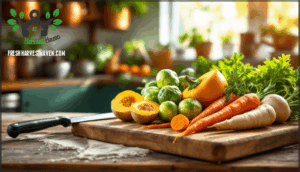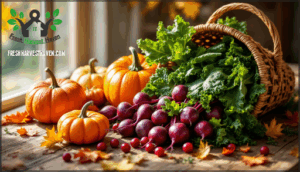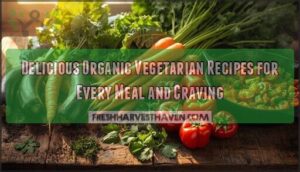This site is supported by our readers. We may earn a commission, at no cost to you, if you purchase through links.
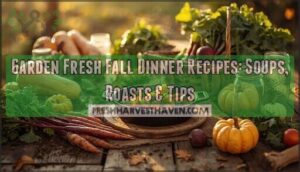
Garden fresh fall dinner recipes transform these nutrient-packed ingredients into warming meals that satisfy both your taste buds and your body’s seasonal needs. The trick lies in knowing which autumn vegetables deliver the most flavor and how to coax out their natural sweetness through simple cooking methods.
With a few strategic techniques and the right combinations, you’ll turn your harvest into comforting dinners that make the effort of gardening worth every minute.
Table Of Contents
- Key Takeaways
- Garden Fresh Fall Dinner Recipes
- Hearty Soups and Stews for Autumn
- Roasted and One-Pan Vegetable Dinners
- Cooking Techniques for Fall Flavors
- Seasonal Meal Planning and Ingredient Tips
- Frequently Asked Questions (FAQs)
- What are some healthy fall dinner ideas?
- What is a quick and easy fall dinner?
- What is a quick and easy meal to make in early fall?
- What to eat in autumn?
- What should early fall dinners be easier than?
- Should early fall dinners be as easy as pie?
- How do I preserve fall herbs for winter use?
- Whats the best way to freeze autumn vegetables?
- Can I substitute canned pumpkin for fresh squash?
- How long do roasted fall vegetables stay fresh?
- Conclusion
Key Takeaways
- Fresh fall vegetables harvested at peak ripeness contain up to 30% more antioxidants and vitamins than stored produce, making garden-to-table cooking nutritionally superior to buying off-season imports.
- Roasting at 425°F for 25-40 minutes transforms fall vegetables like butternut squash, sweet potatoes, and root vegetables by caramelizing their natural sugars and creating golden, crispy edges that intensify flavor.
- Sheet-pan dinners and one-pot meals simplify fall cooking by combining proteins with seasonal vegetables in a single dish, minimizing prep work while maximizing the harvest’s natural flavors.
- Proper storage techniques—like keeping root vegetables in cool, humid conditions and blanching before freezing—extend your fall harvest for months, turning surplus produce into winter meals without waste.
Garden Fresh Fall Dinner Recipes
When fall arrives, your garden offers a bounty of vegetables and fruits that can transform into comforting, flavorful dinners. Cooking with seasonal ingredients means you’re working with produce at its peak—fresher, tastier, and often more affordable than off-season options.
Let’s look at how seasonal cooking benefits your table, which fall ingredients deserve a spot in your kitchen, and simple ways to make the most of your harvest.
Benefits of Seasonal Cooking
When you cook with what’s ripe right now, you’re tapping into nature’s calendar for the best flavor quality and nutritional value. Seasonal produce packs up to 30% more antioxidants than stored alternatives, and vitamin C levels stay intact when you harvest fresh instead of waiting months.
Benefits of seasonal cooking extend beyond health benefits—you’ll spend 15–30% less on fall vegetables since local abundance drives prices down during harvest season. Your wallet and the local economy both win.
Plus, choosing garden fresh fall dinner recipes cuts your carbon footprint by up to 70% compared to out-of-season imports, reducing environmental impact through less packaging and transportation. Fall flavors shine brightest when seasonal cooking guides your menu.
Eating seasonally also helps to guarantee optimal nutrient intake.
Key Fall Vegetables and Fruits
Knowing which autumn vegetables and fall vegetables actually thrive right now helps you plan dinners that taste better and cost less. California supplies roughly 71% of fresh fall vegetables in the U.S., while peach production in the Southeast has rebounded with yields up by hundreds of percentage points this season.
Your best picks for autumn include:
- Pumpkin: One cup cooked delivers over 200% of your daily vitamin A needs, supporting vision and immune health.
- Sweet potato: Peak sales run September through November, offering 16% of daily fiber and 35% of vitamin A per serving.
- Butternut squash and other root vegetables: These provide about 10% of daily potassium requirements per cup.
- Leafy green vitamins from kale: A single cooked cup covers 100% of your vitamin K needs.
Apple harvest trends show tighter supplies this year, while cranberry production is forecast to increase nationwide, giving you plenty of options for seasonal cooking. Eating these seasonal fruits can support immune function.
Tips for Maximizing Garden Harvests
Once you’ve picked the best produce from your garden, a few simple strategies can help you squeeze out every last tomato, squash, and bundle of greens before the first hard freeze arrives. Harvest timing matters more than you think—checking plants daily lets you catch vegetables at peak ripeness. Succession planting keeps your beds productive longer, while row covers extend your season by shielding crops from light frosts. Strong soil health now sets you up for next year’s garden fresh fall dinner recipes.
Watch for these signals that get the most out of garden harvests:
- Morning dew glistening on ripe tomatoes ready for tonight’s sauce
- Squash stems turning woody, signaling it’s time to harvest
- Beneficial insects patrolling leaves, your natural pest control allies
- Compost darkening and crumbling, ready to enrich tired beds
- Seed pods drying on your healthiest plants, perfect for seed saving
Smart watering strategies and creative ways to use surplus vegetables turn bumper crops into fall harvest recipes worth repeating.
Hearty Soups and Stews for Autumn
When the air turns crisp and leaves start to fall, nothing beats a steaming bowl of soup or stew made with fresh garden vegetables. These recipes turn seasonal produce into meals that warm you from the inside out.
Here are four go-to options that’ll become staples in your fall dinner rotation.
Sausage, White Bean, and Kale Soup
When the weather turns crisp and leaves start crunching underfoot, nothing hits the spot quite like a bowl of this rustic Italian-inspired soup. The combination of savory sausage, tender white beans, and nutrient-packed kale creates one of those hearty soups and stews that feels like a warm hug from the inside out.
This fall dinner recipe showcases fall vegetables beautifully. Flavor enhancers like garlic, red pepper flakes, or fresh rosemary take it up a notch. Soup variations work well—swap ingredients based on what’s in your garden. These soup recipes freeze perfectly for busy weeknights ahead.
| Component | Best Choices | Cooking Notes |
|---|---|---|
| Sausage selection | Italian, chorizo, turkey | Brown 5-7 minutes until crispy |
| Bean pairings | Cannellini, navy, great northern | Simmer 20 minutes for creamy texture |
| Kale types | Curly, lacinato, baby | Add last 5 minutes to keep vibrant |
Sweet Potato Chili With Pinto Beans
There’s something about the earthy sweetness of fall sweet potatoes meeting smoky chili spices that just makes sense on a cool October night. This vegetarian protein source combines orange-fleshed sweet potato varieties with pinto beans—just soak them overnight for the best texture.
Fire-roasted tomatoes and chili spice blends build layers of flavor, while cumin adds warmth. Dice your root vegetables evenly so everything cooks through at the same pace.
Top with avocado, sharp cheddar, or fresh cilantro to make this fall harvest favorite your own.
Creamy Butternut Squash Soup
Butternut squash soup practically makes itself once you nail the roasting step—that’s where the magic happens. Halve your squash, drizzle with olive oil, and roast until the edges caramelize.
Blend with sautéed onions and vegetable broth until silky—no cream needed for that velvety texture. Try sage and nutmeg for classic flavor pairings, or swap dairy for coconut milk in vegan options.
Top with toasted pepitas or crispy sage leaves for crunch.
Chicken Pot Pie Soup
All the comfort of traditional pot pie lands in your spoon without rolling a single crust. Start with leftover chicken and sauté your vegetable medley—carrots, celery, peas—in butter until tender. Build depth with chicken broth variations, adjusting creaminess levels to taste.
- Simmer rotisserie chicken with mixed vegetables in rich broth
- Add cream or milk for silky, pot-pie-style texture
- Top with buttery crust toppings like puff pastry squares
- Customize thickness for your perfect cozy fall dinner
This comfort food recipe transforms soup recipes into fall dinner recipe ideas worth repeating.
Roasted and One-Pan Vegetable Dinners
When fall vegetables are at their peak, roasted and one-pan dinners make weeknight cooking almost simple. These recipes let you pack hearty vegetables, proteins, and grains into simple dishes that come together without much fuss.
Here are four satisfying options that bring out the best in your garden harvest.
Stuffed Butternut Squash With Sausage and Rice
If you’ve ever wanted a meal that practically cooks itself while looking impressive enough for company, this roasted squash turns into an edible serving bowl that does exactly that. Halve your butternut squash lengthwise, scoop out the seeds, then roast cut-side down until fork-tender. Brown your choice of Italian sausage—sweet or spicy work beautifully—and mix with cooked wild rice, fresh sage, and sharp cheddar.
| Component | Best Choices |
|---|---|
| Sausage Variations | Italian (mild/spicy), chicken, turkey |
| Rice Options | Wild rice, brown rice, quinoa blend |
| Cheese Pairings | Sharp cheddar, gruyere, parmesan |
Pack this mixture into your roasted fall vegetables, top with extra cheese, and bake until golden. These stuffed squash recipes celebrate the fall harvest beautifully while keeping cleanup minimal—the seasonal vegetables become your serving dish.
Maple-Roasted Vegetables With Chicken or Pork
When maple syrup meets the high heat of your oven, it transforms ordinary weeknight proteins and vegetables into a caramelized dinner that tastes like you spent hours in the kitchen.
Choose boneless chicken thighs or pork tenderloin, then surround them with chunked butternut squash, carrots, and Brussels sprouts cut into uniform pieces.
Whisk maple syrup with Dijon mustard and fresh rosemary for your glaze. Roast everything at 425°F for thirty-five minutes until the vegetables develop golden edges and your protein reaches safe internal temperatures.
Sheet-Pan Dinners With Root Vegetables
Root vegetables don’t just survive the first frost—they actually taste sweeter after it, making them the backbone of simple sheet-pan dinners all autumn long.
Cut carrots, parsnips, and potatoes into even chunks for uniform roasting. Toss them with olive oil and sheet-pan spices like rosemary and thyme, then add one-pan proteins such as sausage or chicken. Roast at 425°F until everything develops golden, caramelized edges—usually thirty-five to forty minutes. Save leftovers for quick grain bowls or hearty breakfast hashes.
Baked Spaghetti With Garden Greens
After a week of roasting hearty roots and vegetables, baked spaghetti brings all those garden greens you’ve been harvesting into one bubbling, cheesy dish that feels like a warm hug on a cool October night.
Toss cooked pasta with sautéed kale or spinach, layer with ricotta and mozzarella, then bake until golden. The crispy edges and bubbly cheese make this vegetarian option perfect for easy dinner ideas, and leftovers reheat beautifully for next-day lunches.
Cooking Techniques for Fall Flavors
The way you cook fall vegetables can make or break a dish. A few solid techniques turn ordinary produce into something that actually tastes like the season.
Here’s what works best when you’re working with your garden harvest.
Roasting and Grilling Methods
Few cooking techniques transform autumn produce quite like the powerful duo of roasting and grilling—two methods that coax out caramelized sweetness and smoky depth from even the humblest vegetables. Roasting temperatures around 425°F work magic on root vegetables in 25-30 minutes, creating crispy edges and tender centers.
Grilling marinades with maple or balsamic heighten natural sugars, while indirect grilling prevents burning. Vegetable charring on Brussels sprouts or butternut squash adds smoke infusion that turns simple fall vegetables into show-stopping autumn vegetables worthy of your best fall dinner recipes.
Braising and Searing Tips
Searing and braising work hand in hand—once you’ve got those crispy, golden edges from high heat, you can slow-cook your fall ingredients in flavorful liquid until they’re melt-in-your-mouth tender. A heavy Dutch oven distributes heat evenly, perfect for meat and vegetable combinations like beef with carrots or pork with parsnips.
After searing, use deglazing techniques to capture those browned bits stuck to the pan—they’re packed with flavor. Lower the heat, add stock or cider, and let everything simmer gently until the flavor profiles deepen and your fall vegetables practically fall apart.
Blending and Pureeing for Silky Soups
Once you’ve mastered the art of building flavor through braising, the next step is turning those tender vegetables into velvety smooth soups that feel like a warm hug in a bowl. An immersion blender makes the job easy—no transferring hot liquids between containers.
For perfect soup textures, blend in stages: start with half your butternut squash or pumpkin for body, then pulse the rest for bits of texture. Blending safety matters, so pull the pot off heat first.
Want creamy alternatives without heavy cream? Pureed white beans create luxurious puree consistency naturally.
Using Fresh Herbs and Seasonings
Fresh herbs don’t just season your fall dinners—they reveal layers of flavor that dried versions can’t touch. Garden herbs like sage and thyme are perfect for flavor development in autumn dishes.
Try these herb pairings and seasoning blends:
- Sage with butternut squash and brown butter for natural sweetness
- Rosemary with roasted root vegetables and pork for earthy fall flavors
- Thyme with mushrooms and poultry for depth
Master flavor layering by adding delicate herbs at the end and woody ones early. Drying herbs preserves your harvest, while fresh spice blends offer immediate flavor pairings that transform ordinary ingredients.
Seasonal Meal Planning and Ingredient Tips
Planning your fall dinners gets easier when you know how to work with what’s in season. Smart shopping, storage, and a little creativity turn garden-fresh produce into meals that work for your schedule and taste.
Here’s what you need to keep your autumn cooking simple and satisfying.
Selecting and Storing Fall Produce
Knowing which produce to grab—and how to keep it fresh for weeks—can turn a single harvest into a month’s worth of dinners. Peak seasonality matters when selecting fall vegetables like kale, butternut squash, and beets. Look for quality indicators: firm textures, vibrant colors, and unblemished skin signal freshness that lasts. Proper storage extends shelf life considerably.
- Root vegetables thrive in cool, humid spots—try root cellaring with sawdust layers
- Blanch vegetables like broccoli or Brussels sprouts before freezing in airtight containers
- Winter squash keeps for months stored dry at 50-55°F, avoiding waste
- Local sourcing from farmers’ markets guarantees fresher picks for maximizing garden harvests
Adapting Recipes for Dietary Needs
Dietary needs shouldn’t limit your fall cooking. Gluten-free options like buckwheat flour and quinoa maintain texture without wheat—bread with 1.9% guar gum mimics French bread perfectly.
Vegan modifications work beautifully with cashew or oat milk in creamy soups, and plant-based proteins like lentils deliver 18 grams of protein per cup.
Low-carb swaps using cauliflower rice reduce carbs by 35%, while diabetic adaptations favor root vegetables over grains, lowering glucose spikes by 27%.
Allergy substitutions with seed butters keep recipes safe and delicious.
Organizing Pantry for Fall Cooking
Stock your pantry with fall’s finest ingredients to reveal cozy dinner potential. A well-organized pantry makes seasonal meal planning simple. Start with an inventory staples check—list what you have before bulk buying cinnamon, sage, or dried beans. Storage solutions matter: airtight containers keep spices potent and grains fresh longer. A simple labeling system prevents waste and helps you rotate ingredients before they expire. Group pantry staples by category—warming spices together, root vegetable bins separate from canned goods. This setup streamlines ingredient tips into action, letting you grab what you need without rummaging. Seasonal meal planning becomes second nature when everything has its place.
- Pantry staples: Stock butternut squash, sweet potatoes, maple syrup, and apple cider vinegar
- Spice essentials: Store cinnamon, thyme, and rosemary in airtight containers away from heat
- Bulk buying wins: Purchase dried beans, grains, and nuts in larger quantities to save money
- Reducing waste: Use a labeling system with dates to rotate ingredients and minimize spoilage
Creative Ways to Use Surplus Vegetables
When your garden gives more than you can eat fresh, it’s time to turn that abundance into something you’ll thank yourself for all winter long. Freezing seasonal vegetables in portioned bags locks in nutrients and flavor—just blanch root vegetables first. Creative freezing works for shredded zucchini you’ll bake into breads later.
Pickling surplus transforms cucumbers, beets, and beans into tangy treats. Vegetable fermentation turns cabbage and radishes into probiotic-rich sides.
Toss aging produce into fall soups or roast them for easy vegetable dishes. Composting scraps feeds your soil for next season. You can even try regrowing vegetables from kitchen scraps—celery and green onions bounce back easily. These vegetable recipes stretch your harvest without letting anything go to waste.
Frequently Asked Questions (FAQs)
What are some healthy fall dinner ideas?
You’ll love how seasonal vegetables transform into nourishing dinners. Roasted butternut squash with sage, kale salads dotted with cranberries, and sweet potato chili deliver vitamins and comfort.
Try low-carb options like stuffed peppers, vegan fall meals with white beans, or gluten-free dinners featuring hearty soups and stews using garden fresh ingredients.
What is a quick and easy fall dinner?
Try sheet-pan roasted butternut squash with sausage and kale for quick and easy dinners. Toss everything with olive oil, season well, and roast for thirty minutes at 425°F.
This weeknight dinner uses minimal prep and delivers satisfying, easy fall recipes without fuss.
What is a quick and easy meal to make in early fall?
Sheet-pan roasted butternut squash with sausage and kale is perfect for busy weeknights.
Toss everything with olive oil, season generously, and roast for thirty minutes—you’ll have a complete, hands-off meal that practically cooks itself.
What to eat in autumn?
Autumn’s bounty practically begs you to abandon sad salads and dive headfirst into comfort foods. Think velvety butternut squash soups, crispy roasted Brussels sprouts with bacon, apple-stuffed pork chops, and pumpkin bread that transforms your kitchen into fall heaven—all celebrating seasonal recipes and garden harvest flavors.
What should early fall dinners be easier than?
Early fall dinners should be easier than heavy summer cooking sessions. Quick weeknights call for simple prep and minimal cleanup using easy ingredients.
These easy fall recipes make quick meals possible—think batch cooking soups or quick and easy recipes that highlight fresh harvest flavors without complicated steps.
Should early fall dinners be as easy as pie?
You’re looking at the low-hanging fruit of fall cooking. Quick meal prep and simple ingredients transform weeknight dinners into simple cooking.
Easy fall recipes using sheet pans and one-pot methods deliver time-saving recipes without sacrificing comfort or flavor.
How do I preserve fall herbs for winter use?
Freezing fresh herbs in ice cubes preserves their bright flavor for winter cooking. Alternatively, hang bundles upside down in a cool, dark spot until completely dry. Both herb drying methods lock in the fall harvest’s essence for seasonal fall dinner ideas year-round.
Whats the best way to freeze autumn vegetables?
Imagine this: a freezer full of summer’s bounty, ruined by ice crystals because you skipped one essential step. Blanching techniques protect your fall harvest from freezer burn. Drop Brussels sprouts and broccoli into boiling water for two minutes, then shock them in ice water. Dry them thoroughly—moisture is the enemy here.
Freeze vegetables in single layers on trays before packing into airtight storage containers. This method preserves seasonal vegetables for your favorite vegetable dishes all winter, making fall cooking possible year-round.
Thawing methods matter too: use gentle heat or overnight refrigeration.
Can I substitute canned pumpkin for fresh squash?
You can swap canned pumpkin for fresh butternut squash in most fall recipes. Canned pumpkin’s smoother texture works great in soups and baked goods, though fresh squash brings slightly sweeter flavor and firmer consistency to roasted dishes.
How long do roasted fall vegetables stay fresh?
Roasted vegetables keep for three to five days in your fridge when stored in airtight storage containers.
For best results with seasonal vegetables, cool them completely before refrigerating and reheat gently to preserve texture in your fall recipes.
Conclusion
Your garden’s autumn harvest deserves more than routine treatment—it deserves recipes that honor its flavor, get the most from its nutrition, and turn dinner into something worth gathering around.
These garden-fresh fall dinner recipes work because they respect what the season offers: sweet squash that caramelizes under heat, hearty greens that soften into soups, root vegetables that become tender and rich when roasted.
You’ve grown it, you’ve tended it, and now you’ve transformed it into meals that warm from the inside out.

